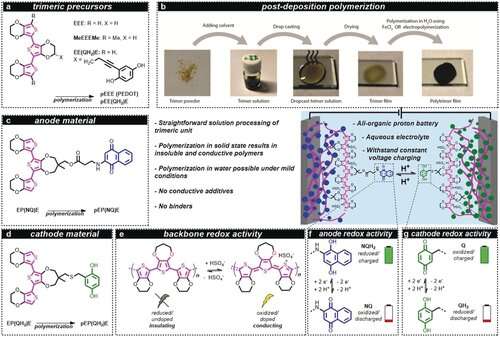An all-organic proton battery energized for sustainable energy storage

Sustainable energy storage is in great demand. Researchers at Uppsala University have therefore developed an all-organic proton battery that can be charged in a matter of seconds. The battery can be charged and discharged over 500 times without any significant loss of capacity. Their work has been published in the scientific journal Angewandte Chemie.
The researchers have been able to demonstrate that their battery can be easily charged using a solar cell. Charging can also be accomplished without the aid of the advanced electronics that, for example, lithium batteries require. Another advantage of the battery is that it is unaffected by ambient temperature.
"I'm sure that many people are aware that the performance of standard batteries declines at low temperatures. We have demonstrated that this organic proton battery retains properties such as capacity down to as low as -24°C," says Christian Strietzel of Uppsala University's Department of Materials Science and Engineering.
A great many of the batteries manufactured today have a major environmental impact, not least due to the mining of the metals used in them.
"The point of departure for our research has therefore been to develop a battery built from elements commonly found in nature and that can be used to create organic battery materials," explains Christian Strietzel.
For this reason, the research team has chosen quinones as the active material in their battery. These organic carbon compounds are plentiful in nature, among other things occurring in photosynthesis. The characteristic of quinones that researchers have utilised is their ability to absorb or emit hydrogen ions, which of course only contain protons, during charging and discharging.
An acidic aqueous solution has been used as an electrolyte, the vital component that transports ions inside the battery. As well as being environmentally friendly, this also provides a safe battery free from the hazard of explosion or fire.
"There remains a great deal of further development to be done on the battery before it becomes a household item; however, the proton battery we have developed is a large stride towards being able to manufacture sustainable organic batteries in future," says Christian Strietzel.
More information: Christian Strietzel et al. An aqueous conducting redox polymer based proton battery that can withstand rapid constant‐voltage charging and sub‐zero temperatures, Angewandte Chemie International Edition (2020). DOI: 10.1002/anie.202001191
Journal information: Angewandte Chemie , Angewandte Chemie International Edition
Provided by Uppsala University

















